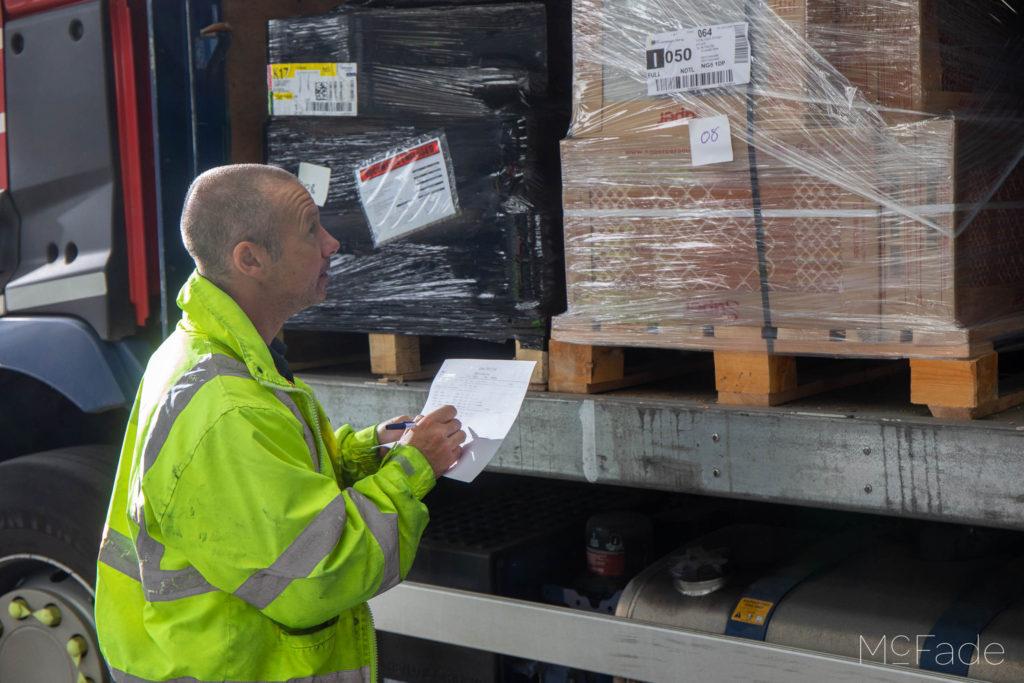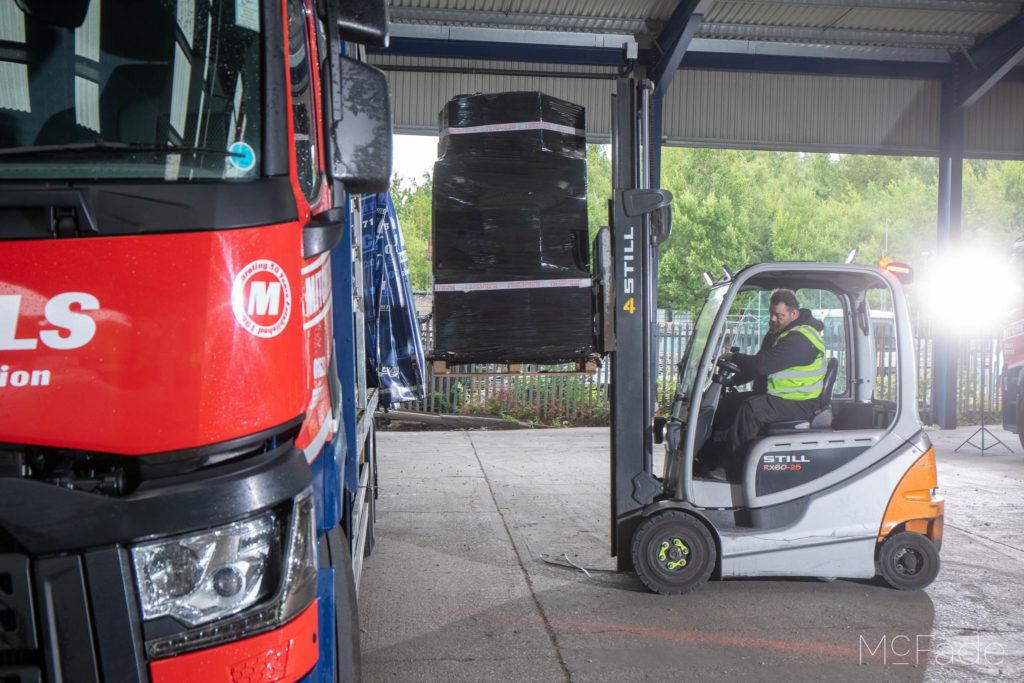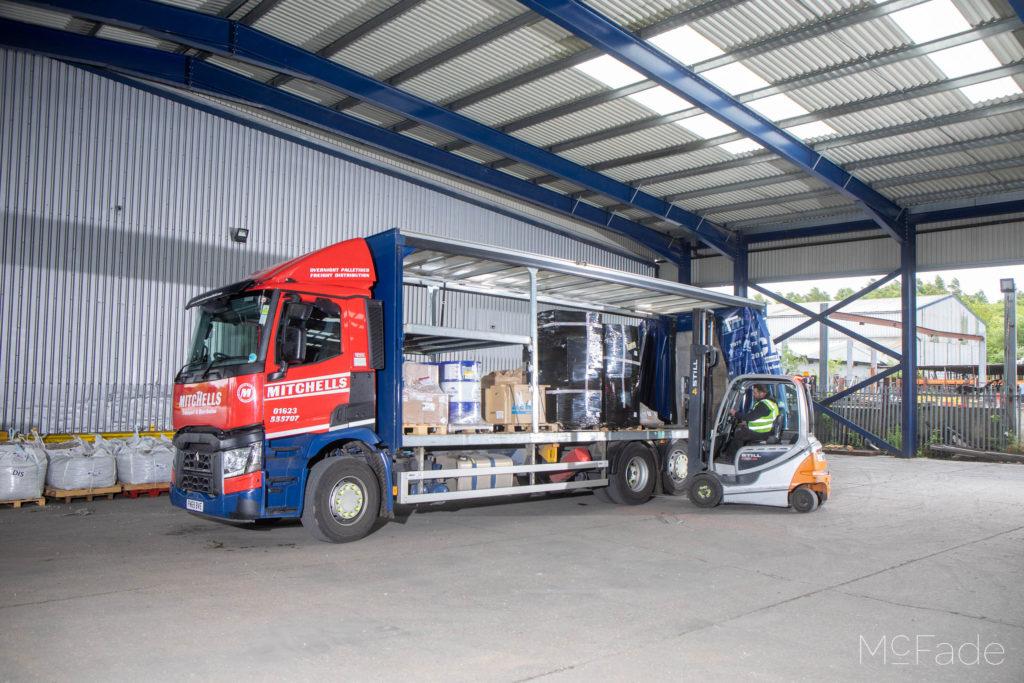The last thing you want to hear after shipping your cargo is that they have arrived to your customer damaged! This causes a loss of time, money and potentially both yours and our reputation.
At Mitchells we want to make sure your delivery with us goes as smoothly as possible and help you prevent cargo damage. To achieve this we need to ensure your pallets and goods are secure. We’ve put together a checklist to ensure your products get to their destination in one piece.
Although we can’t always guarantee your cargo won’t be damaged, by following these tips you’ll be able to prevent potential transit damage.
Follow our guide below to prevent damage to your goods during transit!
How do you prevent cargo damage:
- Correctly package your goods
- Seal your boxes
- Choosing the correct pallet base
- Stacking your pallet to avoid collapse
- Labelling your goods so they don’t get lost
- Strapping your goods to the pallet
- Insure your goods
- Preventing cargo damage FAQs
Save your money, time and reputation
The supply chain is a vital part of your business and most of the time one of the few that you have little control over. That’s why it’s important to prep your goods well to avoid cargo damage.
“Taking these precautionary steps before your goods are collected can save you time later down the line so no problems arise. It’s not just your money on the line when cargo gets damaged, it’s also your reputation and ours!”
Richard Montgomery, MD of Mitchells.
You want to ensure you provide your customers with the best possible service and we want to help you achieve this.
Over time consistent damaged cargo will lead to a loss of profits! And you want to make sure your business is as profitable as possible.
There are many things that can go wrong when it comes to transporting your goods, so it’s best to practice these safety measures below.

Correctly package your goods
Just like Goldilocks, we need your items to be packaged safely in a box that isn’t too big, too small but just right.
With boxes that are too big, this will allow your items to move during transit and break. Boxes that are too small may tear during transit and goods could be lost.
Ensure your goods fit into the box with enough room to use packaging material. This will protect your goods and your cargo will arrive to your customer safely.
It’s always good practice to pack your most delicate items separately. It’s always best to separate items that are easily damaged and ensure they are packed with plenty of packaging materials to prevent damage during transit.
We know many of you want to be more eco-friendly and using recyclable boxes is totally okay. Just inspect the box before use, ensuring there is no damage such as tears or water damage. These can affect the structural integrity of the box while in transit from the prolonged vibrations.
Don’t forget to check the weight limit of your packaging. Just because you can fit more items in, doesn’t mean you should. And if your items would be safer in a crate we would recommend using one. This will also help avoid damage to your pallet too.
There are a variety of boxes on the market that won’t be up for the job. Make sure the quality of the box you use will be able to handle the delivery of your cargo.
The internal packaging of your boxes is just as important as the box itself. The vibrations from the road and engine can cause items to shift so ensuring your boxes are well-packaged is imperative.
Some common materials you can package your items are:
- Paper
Great for wrapping delicate items with however it may not have great impact protection.
- Bubble wrap
Bubblewrap is light weight and provides your goods with great impact protection while in transit.
- Styrofoam
A good option for packing as they come in a variety of sizes and shapes. From fitted sheets to peanuts, styrofoam offers great impact protection.
Seal your boxes
So now you’ve packed your goods in the correct way. But what about sealing your goods?
Not using the correct seal or adhesive will undo all of your hard work in correctly packaging your cargo.
There’s a variety of seals you can use. It all depends on what you’re using to pack your goods and the temperature during transit.
- Vinyl Packaging Tape
PVC or vinyl packaging tape is a great choice for anyone who needs a strong, durable tape that can withstand cold temperatures. It’s easy to apply, whether you’re using your hands or a dispenser, and it’s more tear-resistant than standard polypropylene tape. This makes it the perfect choice for packaging products that will be stored in refrigerated environments.
- Brown Packaging Tape
Brown packing tape is the most common type of packing tape. It is used for bundling, sealing, and wrapping items. It is a strong and reliable tape that is ideal for a variety of packaging needs.
- Paper Packaging Tape
Paper parcel tape is a classic choice for packaging that is making a comeback. Made from tear-resistant paper and water-activated adhesive, it creates a strong, tamper-resistant seal when activated with a little moisture. Plus, it’s eco-friendly and sustainable, as it’s both biodegradable and recyclable.
- Reinforced Packaging Tape
Heavy-duty packaging tape is the perfect choice for tough jobs. It’s made with glass filaments that make it extra strong and durable, so you can use it to pack up anything from metal and plastic to cardboard and paper.
Choosing the correct pallet base
It’s now time to assemble your packed goods onto your pallet. Using quality pallets that aren’t damaged is vital. There are two types of pallet materials, wood or plastic and each has their own benefits.
Woods pallets are much easier to find, are cheaper and can usually hold a heavier weight. However, plastic pallets are great for shipping foods and liquids in case of any spills as they are easier to clean. This Is a personal preference when it comes to choosing which to send your goods on.
Pallets should not exceed the standard size of 1000 mm x 1200 mm so we can prevent pallet damage during transit.
Depending on what size pallet you have will affect the weight of goods the pallet can handle. Your goods must not overhang the pallet edges.
Here’s a breakdown of pallet sizes we offer:
- Pallet base
Pallet Length: 120 cm / 1200 mm / 1.2m / 48′′
Pallet Width: 100 cm / 1000 mm / 1.0m / 40′′
- Quarter Pallet
Maximum Height: 80 cm / 800 mm / 0.8m / 31.5′′
Maximum Weight: 250 kg
- Half Pallet
Maximum Height: 110 cm / 1100 mm / 1.1m / 43.5′′
Maximum Weight: 500 kg
- Full Pallet
Maximum Height: 200 cm / 2000 mm / 2m / 79′′
Maximum Weight: 1200 kg
We can offer delivery of larger pallets than the ones above or contain cargo that overhang, however these are charged at one pallet space or part thereof.
Your cargo must fit within the pallet dimensions you have paid for. If they do not, you may be charged additional fees for delivery.
To ensure your goods are safe during transport, please make sure they are securely packaged and protected so the chance of cargo damage is reduced. We are unable to package goods for you, but we can place them on a pallet and wrap them in shrink wrap. If your goods are not properly packaged, they may not be covered by our insurance in the event of damage.
Did you know our drivers have the right to refuse to collect your goods if they are not properly packaged or if they appear to be unsafe for transport? So it’s important to get these steps right!

Stacking your pallet to avoid collapse
Nobody wants a pallet that looks like the leaning Tower of Pisa!
So we’ve set out a few tips to ensure your cargo is safe while in transit.
- Separate your boxes by weight
This will help you to decide which ones need to be at the base of the pallet.
Hint: your heaviest boxes need to be on the bottom.
Make sure the weight is evenly distributed on the pallet.
- Do not stack your boxes in the form of a pyramid
We know this might look fun but trust us it won’t be fun when it all comes crashing down! We want to avoid cargo damage and damage to your pallet.
The best way to stack boxes is to have an equal number of boxes on each side and level. This will make the stack more stable and easier to move. Ensure to minimise gaps between each box as this is the perfect opportunity for cargo damage.
- Avoid overhang
But what is overhang? It’s where your boxes are hanging over the edge of the pallet and are much more likely to be damaged!
- Be as flat as you can
If your items can’t be boxed please ensure they lay flat on the pallet with no overhang. This makes it easier for the driver to load your cargo to the truck and is much less riskier. Loose items will also need to be strapped to the pallet.
- Don’t forget the shrinkwrap
Once your cargo is securely placed on the pallet, use shrinkwrap around the perimeter of the pallet. Mitchels offer a pallet wrapping service and will incur a surcharge. Please note that wrap is only weather protection and does not act as a suitable product to secure the goods to the pallet base.
- Strapping your pallet
Shrinkwrap can not be used to strap your cargo to the pallet, that is why it is recommended that you shrink-wrap your goods to the pallet and then use strapping or banding to ensure they are secure during transit. This will give you peace of mind that your goods won’t get damaged or lost during transit. It will also protect your goods from bad weather conditions.
Think! Are your goods fit for transport? They’re going to be loaded and unloaded several times during transit so you need to make sure they are securely packaged.
Labelling your goods so they don’t get lost
Imagine this: you’ve followed our guide to protect your cargo from damage while in transit except for this last simple step. Some of your cargo gets separated from the rest of your pallet. You’ve not labelled each of your boxes. No one is sure where the cargo is meant to be and is lost in transit purgatory forever…
We know it’s a scary thought! But it can easily happen. To ensure this doesn’t happen to you, remember to label your boxes with the recipient’s address and add this to at least two sides of the pallet.
Other info to include on your cargo:
- Does your cargo boxes need to be placed a particular way up? Please label this on your boxes.
- Use fragile tape or stickers so our drivers know when to be extra careful with your cargo.
- If parts of your cargo need to stay cool, remember to label those boxes correctly.
Strapping your goods to the pallet
One of the last steps to ensuring your goods are protected during transit is to strap them to your pallet. To do this use a strap or a band and tightly wrap it around pallets and goods. You can use either a manual strapping tool or an automatic one. You need to make sure that the fastening is strong and wont come undone during transit.
There are a few options to seal your strapping or banding. These include seals, buckles and cable ties. It’s best to use the option that works for you and your goods.
- Polyester strapping
This type of strapping is great for medium to heavy cargo, especially ones susceptible to impact or shifting during transit. And is often the most popular choice for reinforcing heavy goods.
- Polypropylene strapping
Polypropylene strapping is very economical and perfect for enduring lighter loads with shorter transit times.
Insure your goods
Ensuring you’re goods are appropriately financially covered with insurance is vital! So if your cargo does get damaged you’re not out of pocket.
You can check with our customer service teams if you’re unsure about insuring your goods before sending.
Our usual cover is £5 per KG. This means if you have to claim on the insurance the insurers will consider each KG to be worth £5. So if the goods weigh 65kg but are worth £3,000 you will only be covered for £325.
We offer additional insurance for those who need it. Please ensure this is in place before dispatching your pallets.

Preventing cargo damage FAQs
- My goods arrived damaged or missing, what should I do?
When your goods are delivered, the person responsible for accepting and signing for the goods should make an examination of goods to check for damage
If anything is missing or damage is apparent or suspected, the delivery note should be endorsed accordingly using the word “damaged” or “Shortage” or “Goods missing’. The word “unchecked” or similar is not accepted as claused proof of delivery.
Insurance companies will not consider a claim for damage or loss when a “clean” or “clear” proof of delivery is produced.
- Where can I buy shrink wrap and other protective items for my pallet?
Shrink wrap is commonly available on the internet. Mitchells also offer a shrink-wrapping service. This incurs a supercharge so please ensure you tell us when ordering.
- What does damage during transit mean?
Damaged during transit means your goods have incurred damage while being transported. This can be due to improper handling, lack of pallet and goods prepping.
- How can I avoid damage to my goods?
Following this guide to ensure your goods are secure will prevent damage during transit. As we do not offer a service to package your goods this is on the sole responsibility of the customer.
You can find more of our FAQs here.
We’re ready to help
At Mitchells we want to make sure your cargo gets from point A to B quickly and safely. It’s not just your reputation but also ours. Following the guide above will help prevent lost or damaged cargo from arriving to your customers.
Ready to get your pallet moving? Click here to learn more about our pallet delivery services.